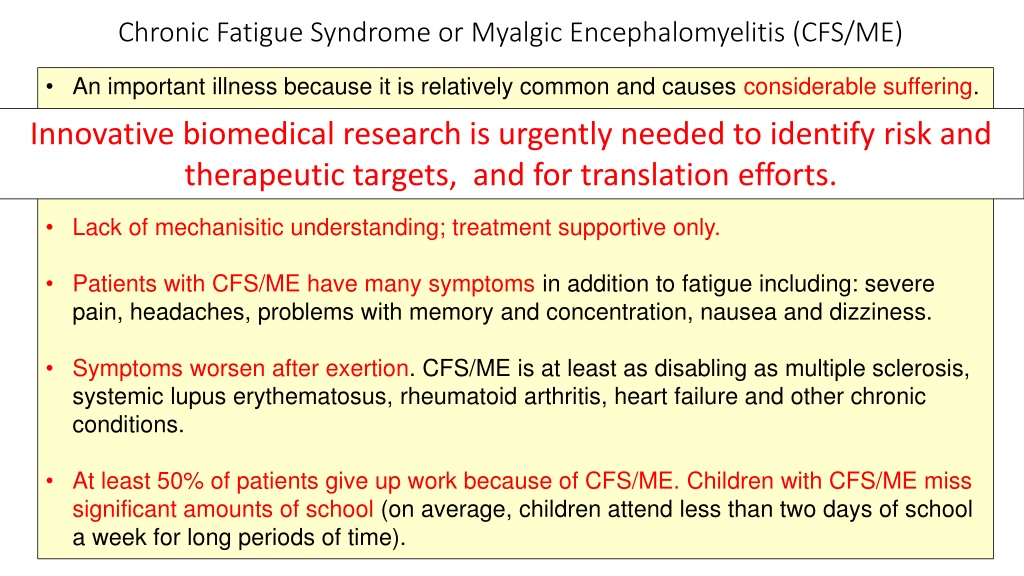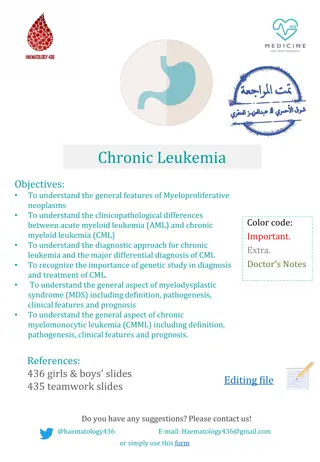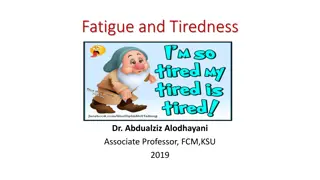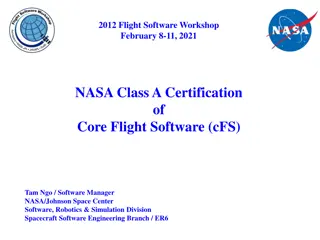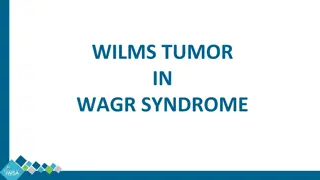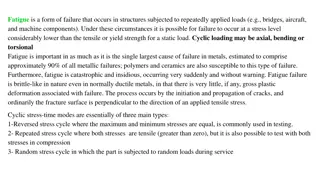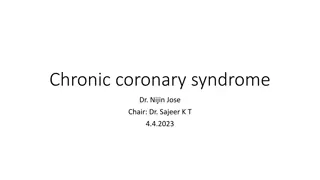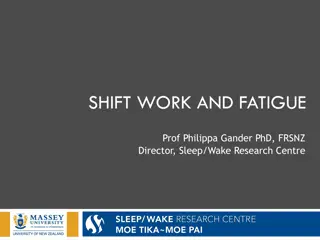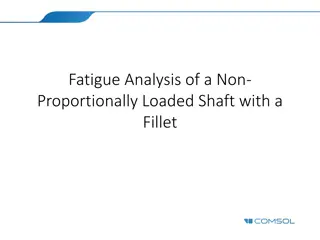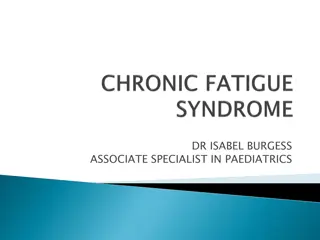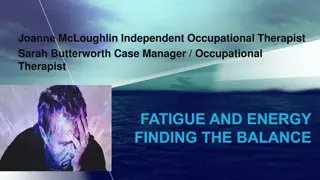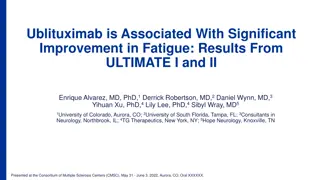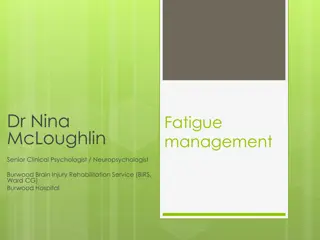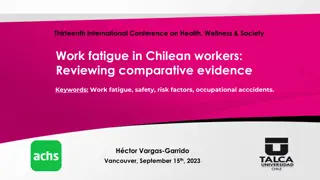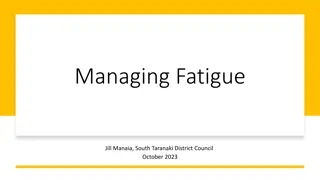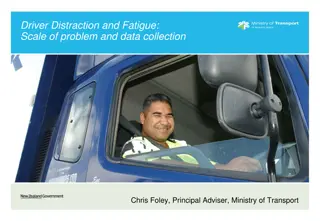Understanding Chronic Fatigue Syndrome (CFS/ME)
Chronic Fatigue Syndrome (CFS/ME) is a debilitating condition affecting millions worldwide, requiring urgent biomedical research for improved treatments. Patients face severe symptoms such as pain, cognitive issues, and disability comparable to other chronic diseases, yet research funding remains low, hindering progress.
Download Presentation

Please find below an Image/Link to download the presentation.
The content on the website is provided AS IS for your information and personal use only. It may not be sold, licensed, or shared on other websites without obtaining consent from the author.If you encounter any issues during the download, it is possible that the publisher has removed the file from their server.
You are allowed to download the files provided on this website for personal or commercial use, subject to the condition that they are used lawfully. All files are the property of their respective owners.
The content on the website is provided AS IS for your information and personal use only. It may not be sold, licensed, or shared on other websites without obtaining consent from the author.
E N D
Presentation Transcript
Chronic Fatigue Syndrome or Myalgic Encephalomyelitis (CFS/ME) An important illness because it is relatively common and causes considerable suffering. Innovative biomedical research is urgently needed to identify risk and M.E. is a serious, long term, fluctuating condition affecting 250,000 people in the UK and 17 million worldwide. therapeutic targets, and for translation efforts. Lack of mechanisitic understanding; treatment supportive only. Patients with CFS/ME have many symptoms in addition to fatigue including: severe pain, headaches, problems with memory and concentration, nausea and dizziness. Symptoms worsen after exertion. CFS/ME is at least as disabling as multiple sclerosis, systemic lupus erythematosus, rheumatoid arthritis, heart failure and other chronic conditions. At least 50% of patients give up work because of CFS/ME. Children with CFS/ME miss significant amounts of school (on average, children attend less than two days of school a week for long periods of time).
. . The invisible disability Research into chronic fatigue syndrome has a rocky past. Now scientists may finally be finding their footing. Amy Maxmen Nature Jan 4th 2018; 553: 14-17 Name a remedy, and chances are that Elizabeth Allen has tried it: acupuncture, antibiotics, antivirals, Chinese herbs, cognitive behavioural therapy and at least two dozen more. She hates dabbling in so many treatments, but does so because she longs for the healthy days of her past. The 34- year-old lawyer was a competitive swimmer at an Ivy-league university when she first fell ill with chronic fatigue syndrome, 14 years ago. Her meticulous records demonstrate that this elusive malady is much worse than ordinary exhaustion. Last year, I went to 117 doctor appointments and I paid $18,000 in out-of-pocket expenses, she says. Dumbfounded that physicians knew so little about chronic fatigue syndrome also known as myalgic encephalomyelitis or ME/CFS Allen resolved several years ago to take part in any study that would have her. In 2017, she got her chance: she entered a study assessing how women with ME/CFS respond to synthetic hormones. After decades of pleading, people with the condition have finally caught the attention of mainstream science and dozens of Elizabeth Allen keeps careful records of the many treatments she has undergone to relieve the symptoms of chronic fatigue syndrome
Why was a Research Collaborative needed in CFS/ME? Chronic Fatigue Syndrome Chronic Fatigue Syndrome Research Foundation Research Foundation Difficulties in getting the condition recognised by the medical profession (despite estimates of illness prevalence ranging from 240,000-600,000). Likely to be more than one disease with multiple causative pathways and levels of severity. Disagreement over mechanisms A complex disorder requiring careful phenotyping and different scientific methods. Very few treatments available symptoms only. Quality of research very variable with much speculation and conjecture based on poor evidence. Low level of research funding which is fragmented. Lack of industry interest.
Research into CFS/M.E. CFS/M.E. research funding is exceptionally low compared to other neurological or multisystem disorders. It is at least as disabling as multiple sclerosis yet, per person, it receives 20-times less funding. People with CFS/M.E. experience a lower quality of life than those with rheumatoid arthritis, cancer or congestive heart failure. Unlike other disorders, CFS/M.E. patients most severely affected currently receive the least care. Frustratingly, therapeutic approaches have failed to deliver tangible benefits for most patients. Patients and patient organisations are now seeking new approaches for discovery of causal biomolecular mechanisms in the face of a medical community that still deny even its very existence.
UK CFS/M.E. Research Collaborative (CMRC) April 2013, the UK CFS/M.E. Research Collaborative (CMRC) was launched to stimulate a national joined-up collaborative research approach involving patients, NHS, charities and the research councils. Its aims were to: Promote current research in CFS/M.E. Review underlying mechanisms and sub-phenotypes of CFS/M.E. Identify research opportunities Encourage new research towards understanding the basis of the disease Produce a framework for conducting high quality research in the future Work to achieve clear lines of communication and synergy among all stakeholders with an interest in this area.
But the time has now arrived to step the effort UK CFS/M.E. Research Collaborative (CMRC) and put CFS/M.E. Research on the front foot Over its 5 years, the CMRC Executive comprised basic and applied researchers in and outside the field, CFS/M.E Medical Charities (Action for M.E., the M.E Association, the CFS Research Foundation, M.E. Research UK, the Association of Young People with M.E. (AYME), the British Association for CFS/ME (BACME), Wellcome Trust and Arthritis Research UK), MRC, NIHR and industry (UCB, GSK, MRCT - LifeArc). Despite some changes to the Medical Charities over the 5 years, with some merging, others leaving and new ones joining, the CMRC remains strong. We have held on average four Executive meetings each year, hosted by MRC, run four annual 2-day meetings (2 in Bristol and 2 in Newcastle) and have held a number of task- orientated workshops.
Why is now a good time: the opportunity CFS/ME fits the new medical paradigm of stratified medicine in being highly complex disorder driven by many underlying causative pathways, leading to different disease subtypes. MRC initiative shows that by bringing new scientists into the field high quality science can achieve grant success increase in confidence of scientific community. The emergence of large collections of patients and biobanks for research. New methods now available to stratify CFS/ME using statistical methods combined with application of omics technologies (genomics, proteomics, metabolomics etc). The use of other diseases to explore subphenotypes of CFS/ME e.g. fatigue in Sj grens syndrome, primary biliary cirrhosis, IFN therapy for hepatitis. CFS/ME Charities enthusiastic to work together for patient benefit. treatments. Recognising this complexity mandates a different approach to uncovering novel cellular and molecular mechanisms (or endotypes). Understanding these endotypes will lead to new diagnostics and What is the recent evidence that investing in large studies and new technologies will deliver new disease approaches
Encouraging early results from the application of omics technologies to well characterised cohorts Genomics and transcriptomics Exercise - induced changes in cerebrospinal fluid miRNAs in Gulf War Illness, Chronic Fatigue Syndrome and sedentary control subjects. Baraniuk JN, Shivapurkar N. Sci Rep. 2017 Nov 10;7(1):15338. Genome-wide association analysis identifies genetic variations in subjects with myalgic encephalomyelitis/chronic fatigue syndrome. Schlauch KA, et al Transl Psychiatry. 2016 Feb 9;6:e730. A targeted genome association study examining transient receptor potential ion channels, acetylcholine receptors, and adrenergic receptors in Chronic Fatigue Syndrome/Myalgic Encephalomyelitis. Johnston S, et al. BMC Med Genet. 2016 Nov 11;17(1):79. Use of single-nucleotide polymorphisms (SNPs) to distinguish gene expression subtypes of chronic fatigue syndrome/myalgic encephalomyelitis (CFS/ME). Shimosako N, Kerr JR. J Clin Pathol. 2014 Dec;67(12):1078-83 Transcription profile analysis of vastus lateralis muscle from patients with chronic fatigue syndrome. Pietrangelo T, et al. Int J Immunopathol Pharmacol. 2009 Jul-Sep;22(3):795-807.
Metabolomics: Metabolic profiling of a myalgic encephalomyelitis/chronic fatigue syndrome discovery cohort reveals disturbances in fatty acid and lipid metabolism. Germain A et al. Mol Biosyst. 2017 Jan 31; 13(2): 371-379. Metabolic profiling indicates impaired pyruvate dehydrogenase function in myalgic encephalopathy/chronic fatigue syndrome. Fluge et al. JCI Insight. 2016 Dec 22;1(21):e89376. Metabolic features of chronic fatigue syndrome. Naviaux RK, et al. Proc Natl Acad Sci U S A. 2016 Sep 13; 113 (37): E5472-80. Fecal metagenomic profiles in subgroups of patients with myalgic encephalomyelitis/chronic fatigue syndrome. Nagy-Szakal D et al. Microbiome. 2017 Apr 26; 5(1) :44. Immune network analysis of cerebrospinal fluid in myalgic encephalomyelitis/chronic fatigue syndrome with atypical and classical presentations. Hornig M, et al. Transl Psychiatry. 2017 Apr 4; 7(4): e1080.
Metabolic features of chronic fatigue syndrome. Naviaux RK, et al. Proc Natl Acad Sci U S A. 2016; 113: E5472-80. We performed targeted, broad-spectrum metabolomics to gain insights into the biology of CFS. We studied a total of 84 subjects using these methods. Forty-five subjects (n = 22 men and 23 women) met diagnostic criteria for ME/CFS by Institute of Medicine, Canadian, and Fukuda criteria. Patients with CFS showed abnormalities in 20 metabolic pathways. Eighty percent of the diagnostic metabolites were decreased, consistent with a hypometabolic syndrome. MALE FEMALE The Life Cycle of C. elegans Growing up Fast, Dealing with Stress Component 2 Component 2 Similar to dauer, CFS appears to represent a hypometabolic survival state that is triggered by environmental stress. The metabolic features of CFS and dauer correspond to the same pathways that chararacterise the response to pathologically persistent or recurrent cell danger signaling. Control Control CFS CFS Component 1 Component 1
Chronic Fatigue Syndrome or Myalgic Encephalomyelitis (CFS/ME): Institute Of Medicine and NIH established a new research initiative BEYOND MYALGIC ENCEPHALOMYELITIS/ CHRONIC FATIGUE SYNDROME Redefining an Illness Committee on the Diagnostic Criteria for Myalgic Encephalomyelitis/Chronic Fatigue Syndrome Board on the Health of Select Populations 17th March, 2015 INSTITUTE OF MEDICINE OF THE NATIONAL ACADEMIES THE NATIONAL ACADEMIES PRESS Washington, D.C. www.nap.edu
Beyond Myalgic Encephalomyelitis/Chronic Fatigue Syndrome: Redefining an Illness Committee on the Diagnostic Criteria for Myalgic Encephalomyelitis/Chronic Fatigue Syndrome, Institute of Medicine. Myalgic encephalomyelitis (ME) and chronic fatigue syndrome (CFS) are serious, debilitating conditions that affect millions of people in the United States and around the world. ME/CFS can cause significant impairment and disability. Despite substantial efforts by researchers to better understand ME/CFS, there is no known cause or effective treatment. Diagnosing the disease remains a challenge, and patients often struggle with their illness for years before an identification is made. Some health care providers have been sceptical about the serious physiological rather than psychological nature of the illness. Once diagnosed, patients often complain of receiving hostility from their health care provider as well as being subjected to treatment strategies that exacerbate their symptoms.
The grants are awarded to: Maureen Hanson, Ph.D., Cornell University, Ithaca, New York; Dr. Hanson and her colleagues will investigate the biological mechanisms underlying ME/CFS by obtaining blood samples and conducting brain scans on individuals with ME/CFS before and after they undergo an exercise test designed to bring on symptoms of post-exertional malaise. W. Ian Lipkin, M.D., Columbia University, New York City; Dr. Lipkin and his team will examine an existing collection of biological samples from people with ME/CFS and healthy controls for microbial agents, such as viruses and bacteria, that may play a role in the disease. Derya Unutmaz, M.D., The Jackson Laboratory, Farmington, Connecticut; Dr. Unutmaz and his group will use novel tools to take a detailed look at how the immune system, the microbiome (our body s complete collection of microbes including bacteria and viruses) and metabolism (the chemical reactions that produce energy for the body) interact in ME/CFS. Data Management and Coordinating Center (DMCC) for the ME/CFS Collaborative Research Centers Rick L. Williams, Ph.D., Research Triangle Institute, Research Triangle, North Carolina; Dr. Williams and his team will lead the DMCC that will bring together research data from the CRCs into one database.
Wednesday, September 27, 2017 Wednesday, September 27, 2017 NIH announces centers for NIH announces centers for myalgic Collaborative projects will advance research and knowledge about debilitating disease. Collaborative projects will advance research and knowledge about debilitating disease. myalgic encephalomyelitis/chronic fatigue syndrome research encephalomyelitis/chronic fatigue syndrome research The National Institutes of Health (NIH) have awarded four grants to establish a coordinated scientific research effort on myalgic encephalomyelitis/chronic fatigue syndrome (ME/CFS). These important grants will provide a strong foundation for expanding research in ME/CFS, and lead to knowledge about the causes and ways to treat people affected by this mysterious, heartbreaking, and debilitating disease, said NIH Director Francis S. Collins, The total cost of the projects for fiscal year 2017 is over $7 million, with support from multiple NIH Institutes and Centers that are part of the Trans-NIH ME/CFS Working Group. The grants will support the creation of a consortium made up of three Collaborative Research Centers (CRC) and a Data Management Coordinating Center (DMCC). The CRCs will each conduct independent research but will also collaborate on several projects, forming a network to help advance knowledge on ME/CFS. CIHR in Canada funded a 5th Centre, we want the UK to be the 6th! The data will be managed by the DMCC and will be shared among researchers within the CRCs and more broadly with the research community.
From the Chief Medical Officer Professor Dame Sally Davies FRS FMedSci CMRC Southampton Jan 18th: Looking forward: Build a national CFS/M.E research platform to undertake: (i) Hypothesis-free investigation determinants of CFS/M.E. susceptibility, (ii) Objective identification of biomarkers using standard and multi- omics technologies stratification. Prof. Stephen Holgate CBE Chair of UK CFS/ME Research Collaborative University of Southampton 39VictoriaStreet 7thFloor LondonSW1H0EU 02072105151 sally.davies@dh.gsi.gov.uk www.gov.uk into the genetic 25 January 2018 that permit CFS/M.E. Dear Stephen, Re: The UK CFS/ME Research Collaborative (CMRC) Research Strategy The CMRC advocates for a high level interdisciplinary report identifying the research needs for patients with CFS/M.E I hope you are well. I am writing to you following a meeting I had with the Secretary of State for Health and Social Care in December during which we discussed current levels of research on Myalgic Encephalomyelitis (ME) / Chronic Fatigue Syndrome (CFS). I understand that the CMRC is exploring the possibility of creating a new research strategy for ME/CFS. I am very interested in this prospect and believe that it would present a great opportunity to establish and highlight the priorities for research in this field and could bring about real progress. Through the NIHR-funded James Lind Alliance , bring patients, carers and clinicians together to agree which, among the many uncertainties, which matter most and deserve priority attention for research. This would build on an earlier 2007 JLA Workshop identifying the need for this. As Chair of the CMRC I wondered if you would be interested in meeting with the Secretary of State for Health and Social Care and Professor Chris Whitty to discuss your proposal at greater length. Professor Whitty is the Department s Chief Scientific Adviser and has overall responsibility for the National Institute of Health Research (NIHR). Both have expressed an interest in the Department being involved in some capacity in the research strategy, and subject to your views, I feel a meeting would represent a valuable next step. Yours ever, Have patients fully involved in helping set the agenda for the CMRC - formed a Patient Advisory Group with representation at all our future meetings. PROFESSOR DAME SALLY C DAVIES FRS FMedSci CHIEF MEDICAL OFFICER
Methodology and experimental design: MEGA recruitment and sample collection New New CFS FUp Services 1-7 Services 8 & 9 Services 10 & 11 Paediatric service 1 250 200? 200? Approach 3620 historical patients, 905 new patients, 820 follow up patients Approach 2000 historical patients, 600 new patients, 620 follow up patients Approach 6040 historical patients, 1510 new patients, 1300 follow up patients Approach 5190 historical patients,1298 new patients, 1170 follow up patients 2 200 170 120 3 334 168 160? 4 275 250 240 Saliva from historical patients: 600 (30%) Saliva from historical patients: 1557 (30%) Saliva from historical patients: 1812 (30%) Saliva from historical patients: 1086 (30%) 5 200 120 120 Year 1 6 500 240 230 Blood and urine new & follow up patients: 603 (35%) Blood and urine new & follow up patients: 983 (35%) Saliva from new and follow up patients: 1111(45%) Saliva from new and follow up patients: 549 (45%) 7 220 150 100 Based upon a smaller version of the Dementia Platform (DPUK), we wish to build a CFS/ME Platform of 10,0000 patients 8 1450 1030 1000 Saliva only: new and follow up patients: 281 (10%) Saliva only: new and follow up patients: 172 (10%) 9 600 480 300 10 683 500 420 Blood and urine New patients: 528 (35%) Blood & urine New patients 316 (35%) 11 540 405 400 Year 2 Saliva for DNA New patients: 270 (45%) including 2000 children. Saliva for DNA New patients: 584 (45%) Plus deep phenotyping: 250 (27%) Saliva only: new and follow up patients: 151 (10%) Annual patient numbers for: 1. Lincolnshire; 2. Yorkshire; 3. Sussex wide; 4. Derby; 5.Dorset, 6 Cornwall; 7. Oxford; 8. London Network; 9. Epson and St Heliers; 10. Northern Network; 11. Bristol Saliva for DNA New patients: 270 (45%) Saliva for DNA New patients: 584 (45%) Blood & urine New patients 316 (35%) Blood and urine New patients: 528 (35%) Year 3 Saliva only: new and follow up patients: 151 (10%) Plus deep phenotyping: 250 (27%) Saliva: Historical patients = 5055; New/follow up patients = 3951. Total = 9006 Blood and urine = 3274. Therefore number samples for GWAS= 12280 Deep phenotyping = 500
Informatics ME/CFS Platform Data Portal Cohort Integration ME/CFS Resources Methods Development Research Networks Experimental Medicine Adult cohort Population genetics Mitochondrial dysfunction Wearables Paediatric cohort Immune dysfunction Imaging ELSI Biobank Pain Patient Advisory Group
